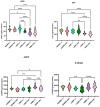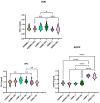Metabolic Rate and Oxidative Stress as a Risk Factors in the Development of Colorectal Cancer
- PMID: 39409042
- PMCID: PMC11476475
- DOI: 10.3390/ijms251910713
Metabolic Rate and Oxidative Stress as a Risk Factors in the Development of Colorectal Cancer
Abstract
There is growing evidence that the body's energy expenditures constitute a significant risk factor for the development of most deadly diseases, including cancer. Our aim was to investigate the impact of basal metabolic rate (BMR) on the growth and progression of colorectal cancer (CRC). To do so, we used a unique model consisting of three lines of laboratory mice (Mus musculus) artificially selected for high (HBMR) and low (LBMR) basal metabolic rate and randomly bred individuals (non-selected, NSBMR). The experimental individuals were implanted with human colorectal cancer cells DLD-1. The variation in BMR between the lines allowed for testing the impact of whole-body metabolism on oxidative and antioxidant parameters in the liver throughout the cancerogenesis process. We investigated the dependence between metabolic values, reactive oxygen species (ROS) levels, and Kelch-like ECH-associated protein 1-based E3 ligase complexes (Keap1) gene activity in these animals. We found that the HBMR strain had a higher concentration of oxidative enzymes compared to the LBMR and NSBMR. Furthermore, the growth rate of CRC tumors was associated with alterations in the levels of oxidative stress enzymes and Keap1 expression in animals with a high metabolic rate. Our results indicate that a faster growth and development of CRC line DLD-1 is associated with enzymatic redox imbalance in animals with a high BMR.
Keywords: colorectal cancer; keap1; metabolic rate; oxidative stress.
Conflict of interest statement
The funders had no role in the design of the study; in the collection, analyses, or interpretation of data; in the writing of the manuscript; or in the decision to publish the results.
Figures









Similar articles
-
Upregulation of nuclear factor (erythroid-derived 2)-like 2 protein level in the human colorectal adenocarcinoma cell line DLD-1 by a heterocyclic organobismuth(III) compound: Effect of organobismuth(III) compound on NRF2 signaling.Biomed Pharmacother. 2020 May;125:109928. doi: 10.1016/j.biopha.2020.109928. Epub 2020 Jan 28. Biomed Pharmacother. 2020. PMID: 32004978
-
Functional and structural changes in aorta of mice divergently selected for basal metabolic rate.J Comp Physiol B. 2020 Jan;190(1):101-112. doi: 10.1007/s00360-019-01252-6. Epub 2019 Dec 23. J Comp Physiol B. 2020. PMID: 31873784
-
Oxidative stress-induced alterations in seminal plasma antioxidants: Is there any association with keap1 gene methylation in human spermatozoa?Andrologia. 2019 Feb;51(1):e13159. doi: 10.1111/and.13159. Epub 2018 Oct 8. Andrologia. 2019. PMID: 30298637
-
Research progress on the regulation of oxidative stress by phenolics: the role of gut microbiota and Nrf2 signaling pathway.J Sci Food Agric. 2024 Mar 15;104(4):1861-1873. doi: 10.1002/jsfa.13062. Epub 2023 Nov 22. J Sci Food Agric. 2024. PMID: 37851871 Review.
-
The role of Nrf2-Keap1 axis in colorectal cancer, progression, and chemoresistance.Tumour Biol. 2017 Jun;39(6):1010428317705510. doi: 10.1177/1010428317705510. Tumour Biol. 2017. PMID: 28621229 Review.
Cited by
-
Basal metabolic rate shapes the development and progression of hepatocellular carcinoma.BMC Cancer. 2025 Jul 1;25(1):1102. doi: 10.1186/s12885-025-14491-4. BMC Cancer. 2025. PMID: 40598035 Free PMC article.
References
-
- Kliemann N., Huybrechts I., Murphy N., Gunter M. Basal Metabolic Rate and Risk of Colorectal Cancer in the European Prospective Investigation into Cancer and Nutrition. Rev. Épidémiologie Santé Publique. 2018;66:S252. doi: 10.1016/j.respe.2018.05.049. - DOI
-
- Maciak S., Sawicka D., Sadowska A., Prokopiuk S., Buczyńska S., Bartoszewicz M., Niklińska G., Konarzewski M., Car H. Low Basal Metabolic Rate as a Risk Factor for Development of Insulin Resistance and Type 2 Diabetes. BMJ Open Diab. Res. Care. 2020;8:e001381. doi: 10.1136/bmjdrc-2020-001381. - DOI - PMC - PubMed
MeSH terms
Substances
Grants and funding
LinkOut - more resources
Full Text Sources
Medical
Research Materials
Miscellaneous

